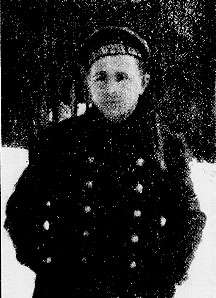Stepan Maximovich Petrichenko
| Stepan Petrichenko | |
|---|---|
 | |
| Chairman of the Soviet Republic of Soldiers and Fortress-Builders of Nargen | |
|
In office December, 1917 – February 26, 1918 | |
| Personal details | |
| Born |
1892 Nikitenka, Kaluga Governorate, Russian Empire |
| Died |
June 2, 1947 (aged 55) Vladimir Prison, Vladimir, Russian SFSR, Soviet Union |
| Nationality | Russian |
| Political party | Socialist-Revolutionary Party |
| Profession | Politician, revolutionary |

Stepan Maximovich Petrichenko (Russian: Степа́н Макси́мович Петриче́нко; 1892 – June 2, 1947) was a Russian revolutionary, an anarcho-syndicalist politician, the head of the Soviet Republic of Soldiers and Fortress-Builders of Nargen and in 1921, de facto leader of the Kronstadt Commune, and the leader of the revolutionary committee which led the Kronstadt rebellion of 1921.
Life
Petrichenko was born in 1892 in the village of Nikitenka in Kaluga Governorate to a family of peasants. Two years after his birth, his family moved to Alexandrovsk, where Stepan graduated from City College and joined the local ironworks as a metalworker. In 1913 Petrichenko was called up for military service with the Russian navy, where he was assigned to the Russian battleship Petropavlovsk, part of the Baltic Fleet.
During the February Revolution in Russia, he had been with the fleet at the Estonian island Nargen (now Naissaar). In December 1917, it was proclaimed a Soviet Republic of Soldiers and Fortress-Builders of Nargen. A republic was launched with eighty-two navy troops guiding about 800 local workers (indigenous had been evacuated at the start of World War I).
Petrichenko fought the Bolsheviks, and the German Empire, aiding in the evacuation of Naissaar on February 26 with the Baltic Fleet in the direction of Helsinki, and from there to Kronstadt.
In 1919 he entered the Russian Communist Party (Bolsheviks) himself, but later resigned (a veiled cleansing). In the summer of 1920, he went home and returned with the approval of Nestor Makhno. He was not a career officer in the Baltic fleet, and when he took the responsibility of guiding the fleet he was an engineer on the battleship Petropavlovsk.
After the rebellion was struck down by Trotsky, he fled over the ice to Finland, where he continued his agitation against the Bolsheviks. He stayed in Finland for many years, until he came into conflict with the Finnish government over his support of Soviet groups during the Winter War between the Soviet Union and Finland in 1940. He was arrested and in 1945 he was expelled to the Soviet Union, where he was soon arrested and deported to Vladimir Prison where he died shortly after.
Work
- Petrichenko, Stepan (1921). Pravda o kronshtadtskikh sobytiiakh. (Russian: Правда о кронштадтских событиях) (bibrec); English: The truth about the Kronstadt events
External links
- The Truth about Kronstadt
- Kronstadt 1921
- "Den russiske revolution i farver" - En kritisk anmeldelse
- Kronstadt: Mentiras anarquistas
- Kronstadt rebellion
- Kronstadt Uprising
- Trotskyist account